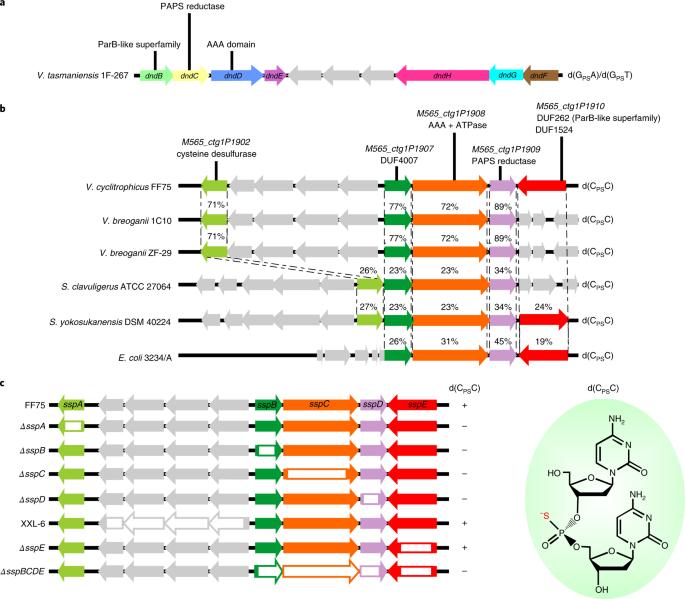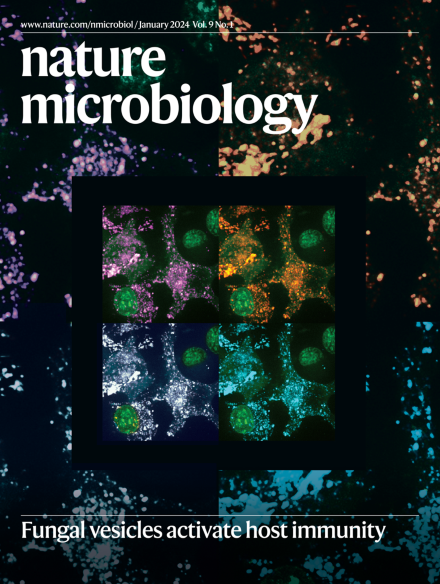SspABCD–SspE is a phosphorothioation-sensing bacterial defence system with broad anti-phage activities
IF 20.5
1区 生物学
Q1 MICROBIOLOGY
引用次数: 63
Abstract
Bacteria have evolved diverse mechanisms to fend off predation by bacteriophages. We previously identified the Dnd system, which uses DndABCDE to insert sulfur into the DNA backbone as a double-stranded phosphorothioate (PT) modification, and DndFGH, a restriction component. Here, we describe an unusual SspABCD–SspE PT system in Vibrio cyclitrophicus, Escherichia coli and Streptomyces yokosukanensis, which has distinct genetic organization, biochemical functions and phenotypic behaviour. SspABCD confers single-stranded and high-frequency PTs with SspB acting as a nickase and possibly introducing nicks to facilitate sulfur incorporation. Strikingly, SspABCD coupled with SspE provides protection against phages in unusual ways: (1) SspE senses sequence-specific PTs by virtue of its PT-stimulated NTPase activity to exert its anti-phage activity, and (2) SspE inhibits phage propagation by introducing nicking damage to impair phage DNA replication. These results not only expand our knowledge about the diversity and functions of DNA PT modification but also enhance our understanding of the known arsenal of defence systems. SspABCD–SspE is a widespread bacterial defence system against phage infection, in which SspABCD is responsible for introducing phosphorothioate modifications and SspE serves as a nickase that cleaves foreign DNA.

SspABCD-SspE 是一种硫代磷酸感应细菌防御系统,具有广泛的抗噬菌体活性
细菌进化出了多种机制来抵御噬菌体的捕食。我们之前发现了 Dnd 系统,该系统利用 DndABCDE 将硫插入 DNA 主干作为双链硫代磷酸酯(PT)修饰,还发现了 DndFGH(一种限制性成分)。在这里,我们描述了环养弧菌、大肠杆菌和横须贺链霉菌中一种不同寻常的 SspABCD-SspE PT 系统,它具有独特的遗传组织、生化功能和表型行为。SspABCD 可产生单链和高频 PT,SspB 可作为切口酶,并可能引入切口以促进硫的结合。令人震惊的是,SspABCD 与 SspE 的结合以不同寻常的方式提供了对噬菌体的保护:(1)SspE 凭借其 PT 刺激的 NTP 酶活性感知序列特异性 PT,从而发挥其抗噬菌体活性;(2)SspE 通过引入切口损伤来抑制噬菌体的繁殖,从而损害噬菌体 DNA 的复制。这些结果不仅扩展了我们对 DNA PT 修饰的多样性和功能的认识,而且加深了我们对已知防御系统库的了解。SspABCD-SspE 是一种广泛存在的细菌防御噬菌体感染的系统,其中 SspABCD 负责引入硫代磷酸酯修饰,而 SspE 则充当裂解外来 DNA 的裂解酶。
本文章由计算机程序翻译,如有差异,请以英文原文为准。
求助全文
约1分钟内获得全文
求助全文
来源期刊

Nature Microbiology
Immunology and Microbiology-Microbiology
CiteScore
44.40
自引率
1.10%
发文量
226
期刊介绍:
Nature Microbiology aims to cover a comprehensive range of topics related to microorganisms. This includes:
Evolution: The journal is interested in exploring the evolutionary aspects of microorganisms. This may include research on their genetic diversity, adaptation, and speciation over time.
Physiology and cell biology: Nature Microbiology seeks to understand the functions and characteristics of microorganisms at the cellular and physiological levels. This may involve studying their metabolism, growth patterns, and cellular processes.
Interactions: The journal focuses on the interactions microorganisms have with each other, as well as their interactions with hosts or the environment. This encompasses investigations into microbial communities, symbiotic relationships, and microbial responses to different environments.
Societal significance: Nature Microbiology recognizes the societal impact of microorganisms and welcomes studies that explore their practical applications. This may include research on microbial diseases, biotechnology, or environmental remediation.
In summary, Nature Microbiology is interested in research related to the evolution, physiology and cell biology of microorganisms, their interactions, and their societal relevance.
 求助内容:
求助内容: 应助结果提醒方式:
应助结果提醒方式:


